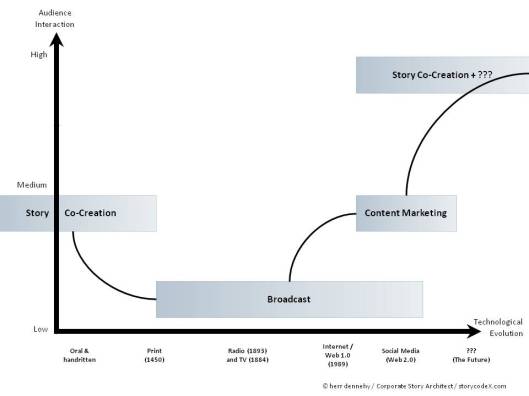Sollten Unternehmen ihren Content im eigenen Hause produzieren oder auf eine Content-Agentur setzen? Content-Experte Tobias Dennehy hat im Siemens Corporate Newsroom beides miterlebt und zeigt die Stärken und Schwächen beider Varianten auf. Für Unentschlossene hat er einen Kompromiss.

Image courtesy of publish! Medienkonzepte GmbH
Herr Dennehy, wann sollte sich ein Unternehmen für die externe Erstellung von Content entscheiden?
Das lässt sich natürlich nicht pauschal beantworten. Eigentlich nur dann, wenn es die Kompetenzen inhouse nicht hat, die es benötigt, um die gewünschten Inhalte in hochwertiger Qualität zu produzieren – und zwar nicht im Sinne einer teuren Hochglanzproduktion, sondern im Sinne eines hohen Werts für mein Publikum. Und da vermutlich kein Unternehmen, egal wie groß, Kompetenzen für alles komplett im eigenen Stab in den Startlöchern haben kann, wird es da immer wieder die berühmten White Spots geben, für die man eine Agentur braucht. Wo die meisten Unternehmen aber in der Tat dringend Unterstützung, frischen Wind und naive Kreativität brauchen, ist bei der Content-Strategie. Hier ist die Handbremse des „Oh, das bekomme ich niemals freigegeben“ in den Köpfen der eigenen Mitarbeiter einfach zu groß, da braucht es unabhängige Impulse von außen. Zusammengefasst: White Spots und Strategie mit Hilfe von außen, den Rest selbst machen.
Sie sind also ein klarer Verfechter der internen Produktion. Worin genau sehen Sie beim Auslagern die Nachteile?
Der größte Nachteil ist, dass man als Unternehmen die Kompetenz über die eigenen Themen und deren Umsetzung in gute Geschichten aus der Hand gibt. Denn was für jeden klar ist, der mal journalistisch gearbeitet hat: Gute Inhalte (oder idealerweise sogar Geschichten) zu produzieren impliziert viel Recherche, bevor man überhaupt anfängt zu schreiben. Und das in diesem Recherche- und Produktionsprozess angeeignete Wissen über die eigenen Themen und Inhalte sollte man als Unternehmen nicht outsourcen. Die daraus resultierende Abhängigkeit gilt es mit allen Mitteln zu vermeiden. Aber auch die individuellen Stimmen der vielen Mitarbeiter, durch die ein Unternehmen idealerweise sprechen und nach denen es klingen sollte, werden durch die namenlosen Redakteure, die bei Agenturen Content im „Corporate Tone of Voice“ des Kunden verfassen, verwischt – und somit charakterlos im buchstäblichen Sinne.
Gute externe Redakteure sind ebenfalls in der Lage, den „Corporate Tone“ zu treffen – Voraussetzung dafür ist, dass Unternehmen sie so nah wie möglich an sich heranlassen…
Nur fürs Protokoll: Ich halte nichts von nivellierendem „Corporate Tone of Voice“. Aber, wenn Sie auf das Thema Zusammenarbeit zwischen Agentur und Kunde anspielen: Ja natürlich, alles andere ist in der Tat kontraproduktiv. Eine Agentur holt man sich doch immer an Bord als Unterstützung, weil man selbst bestimmte Dinge nicht machen kann. Ergo: Man ist auf derselben Seite, oder? Partners in Crime sozusagen. Und von einem Partner erwarte ich ja nicht, dass er immer macht, was ich sage, weil ich ihm Geld gebe, sondern dass er mich immer so berät, als wäre er Teil meines Teams, Teil meines Unternehmens. Wenn Kunde und Agentur sich als ein Team verstehen und eventuell faktisch und organisatorisch sogar so behandelt werden, dann fördert das garantiert die besseren Ergebnisse und erfolgreicheren Projekte zutage. Überhaupt: Content-Agenturen, die sich nur als Exekutive des Kundenwunschs verstehen, sind keine guten Agenturen.
Das ist ein gutes Stichwort: Woran erkennen Unternehmen die passende Content-Agentur?
Zunächst einmal daran, dass sie einem nicht weismachen will, sie könnte alles – ich glaube nicht an Full Service. Vielleicht auch daran, dass sie selbst viel zuhört, bevor sie etwas von sich gibt, und so die Content-Formate findet und kreiert, die einzigartig zum Kunden passen und nicht austauschbar sind wie der meiste Corporate-Content, den wir so vorgesetzt bekommen. Und zuletzt vor allem auch daran, dass sie einem drei Faktoren als Ausgangspunkt empfiehlt und diese auch selbst beherzigt, bevor überhaupt Content produziert wird: Zuhören, Qualität und Planung.
Das müssen Sie genauer erklären…
Wenn ich die Menschen nicht kenne, für die ich Inhalte produzieren will, kann ich auch nicht wissen, was sie wann wo brauchen oder wollen. Also muss ich zuhören, lernen und verstehen – entweder mit technischen Hilfsmitteln oder durch tatsächlichen Dialog, analog oder digital. Der Punkt Qualität meint dagegen, dass richtig guter Content nur dann entstehen kann, wenn dieser dem Anspruch der meinem Unternehmenscharakter zugrundeliegenden Brand-Story gerecht wird und sich dann mit dem inhaltlichen Qualitätsanspruch meines Publikums paart. Und zur Planung: Ich muss wissen, wann bei meinem Publikum welches Thema wo und wie funktioniert – und dann in einem Redaktionsplan dafür sorgen, dass die richtigen Inhalte auch zur richtigen Zeit am richtigen Ort erscheinen.
Für Letzteres waren Sie vor einigen Jahren als Chefredakteur und CvD des Siemens Corporate Newsrooms zuständig. Dort haben Sie auch den Umbruch vom Out- zum Insourcing mitgestaltet. Was gab den Ausschlag für den Wandel?
Erstmals in der Firmengeschichte sollten in der Kommunikation nicht Kanäle und Zielgruppen an den Anfang der Maßnahmenplanung gestellt werden, sondern relevante Themen und Inhalte. Dieser Wandel vollzog sich aus dem Bewusstsein heraus, dass das Internet und seine Weiterentwicklung zum Web 2.0 große Veränderungen mit sich gebracht hat: Zum einen das Verschwimmen medialer Grenzen, was dazu führt, dass es den Menschen egal ist, wo sie gute Inhalte herbekommen, Hauptsache, sie bekommen sie. Dadurch wird übrigens Revolutionäres offenbar: dass Kunden, Mitarbeiter, Journalisten und sogar Investoren keine abstrakten Personae sind, sondern Menschen. Diesen Menschen Hochwertiges und Kongruentes liefern zu können erfordert ein neues Maß an Zusammenarbeit über Abteilungs- und Ressortgrenzen hinweg. Eng damit verbunden ist auch die Geschwindigkeit der Kommunikation, die mich als Unternehmen dazu zwingt, nicht nur schneller zu reagieren, sondern auch proaktiver zu agieren. Nicht nur Shitstorms abzuwenden, sondern auch (scheinbar abwegige) Kommunikationsmöglichkeiten auf dem Radar zu haben. So kann ein Unternehmen agil und abteilungsübergreifend agieren und kommunikative Impulse setzen.
Bei Siemens waren dafür bis zu fünfzig Menschen in einem Newsroom, die an Inhalten für die Firma arbeiteten. Heißt das im Umkehrschluss, dass nur große Unternehmen Inhalte im eigenen Hause produzieren sollten?
Auf keinen Fall. In der Tat braucht sicher nicht jedes Unternehmen einen physischen Newsroom – wenn zehn Leute in der Kommunikation arbeiten, dann ist das Großraumbüro schon ein potenzieller Newsroom. Es geht eher um die „Einstellung Newsroom“. Das Zusammenarbeitenwollen. Zusammen recherchieren. Zusammen produzieren. Zusammen planen. Das ist für jedes Unternehmen heutzutage Pflicht, nicht Kür. Denn wenn meine Presseabteilung eine andere Content-Agenda oder -Strategie fährt als das Marketing, dann wird das früher oder später zum kommunikativen Bumerang. Und klar, je weniger Leute ich an Bord habe, desto mehr White Spots muss ich möglicherweise durch Outsourcing abdecken. Aber auch hier gilt, wie überall: lieber fokussieren und etwas weniger, aber dafür gut machen, als mit einer großen Agenturarmada aus vielen Rohren schießen, dabei diffus bleiben und nichts Außergewöhnliches bringen. „Less is more“ lautet hier die Binsenweisheit.
Weniger ist vor allem auch deshalb mehr, weil der Zeitaufwand bei einer Umstellung auf Inhouse immens ist…
Veränderung ist immer ein langwieriger, schwieriger, aber auch spannender Prozess. Damit das wirklich funktioniert, bedarf es einer komplett neuen Strategie, gegebenenfalls einer neuen Organisation, definitiv neuer Prozesse und eben neuer beziehungsweise anderer Kompetenzen. Da ziehen manche mit, manche rebellieren und manche bleiben indifferent. Man muss einen langen Atem haben und mit gnadenloser Konsequenz an die Sache herangehen, sobald die strategischen Weichen gestellt sind. Aufgeweicht wird alles von selbst in einer großen Organisation, auch ohne das eigene Zutun. Einfach „Ab jetzt inhouse!“ zu beschließen, aber alles sonst zu belassen wie vorher, das wird jedenfalls nicht klappen.
Hätten Sie denn, abgesehen von der internen und externen Produktion, noch einen anderen Vorschlag, wie Unternehmen für ihr Publikum hochwertigen Content erstellen können?
Okay, jetzt wird’s widersprüchlich – aber nur scheinbar. Wenn ich mich recht erinnere, habe ich mich die ganze Zeit als Insourcing-Fan geoutet. Das ist aber nur die halbe Wahrheit. Die andere Hälfte ist eine etwas andere Art des Outsourcings, als wir sie hier die ganze Zeit diskutiert haben. Sie firmiert gemeinhin unter dem Namen Co-Creation. Das heißt, nicht mehr nur für, sondern gemeinsam mit dem Publikum die eigenen Inhalte und vielleicht sogar die eigene Marke neu erschaffen. In Zukunft ist dieses Konzept mit Sicherheit Erfolg versprechend, wenn nicht überlebensnotwendig. Einerseits muss ich als Unternehmen zwar all die eingangs beschriebenen Stufen des Kompetenzaufbaus für die Content-Produktion durchlaufen, um instinktiv zu fühlen, wer ich bin und wie ich erzählen will. In Zeiten sozialmedialer Vernetzung und medienversierter Publika mit erhöhten Ansprüchen an authentische und nachprüfbare Kommunikation müssen wir als Unternehmen aber auch lernen loszulassen, sollten nicht mehr nur Sender der eigenen Geschichten sein, sondern eher Empfänger und Weiterverarbeiter werden. Wir müssen die Markenverbundenheit und Kreativität der Menschen da draußen nutzen, ihnen Impulse und Ideen für Geschichten rund um das eigene Unternehmen geben, ihnen bei der Umsetzung dann freien Lauf lassen und das Ergebnis zielgerichtet zum Teil der eigenen Markengeschichte machen.
*Dieses Interview erschien wortgetreu am 30. Mai 2017 im Content-Marketing-Blog “editorial.” aus dem Hause publish! Das Interview führte die Redakteurin Jacqueline Brunsch.




